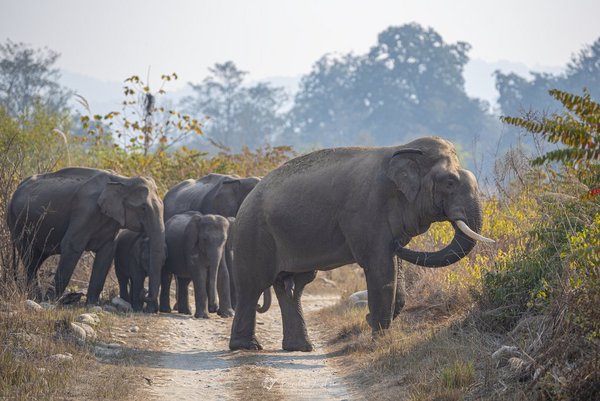- Share this article
- Subscribe to our newsletter
Wildlife crime recording goes digital in the Indian state of Kerala
In Kerala’s capital Thiruvananthapuram, Assistant Conservator of Forests (ACF) Sajesh Kumar is at the forest intelligence cell (FIC), investigating a new wildlife crime case that just turned up. “The FIC was set up in 1997 for early detection and prevention of wildlife crimes. This department also engages in undercover operation relating to crimes such as ivory poaching or sandal wood smuggling. There are high profile offenders engaged in such crime, it would not be possible for department people to directly talk to them. The ivory changes hands from one party to another, and our job is to block this chain”, says Sajesh.
India has stringent laws against ivory poaching and for the protection of elephants. The Asian elephant comes under the red list category of International Union for Conservation of Nature (IUCN). The animal belongs to Schedule I of India’s Wildlife Protection Act (1972). In 1976, it became illegal to export or import any part of the Indian elephant. A decade later, in 1986, India banned all domestic ivory trade.
Elephants also fall under Appendix I of the Convention on International Trade in Endangered Species of Wild Flora and Fauna (CITES). In fact, India was one of the earliest signatories to CITES, and as a signatory, it was obliged to impose a blanket ban on ivory. Despite this, illegal poaching for ivory continues even today.
Pressure on the Asian elephant population
“The elephants are already under severe pressure due to habitat fragmentation in forests. Selective poaching for ivory increases the already high human-elephant conflict,” says Manu Sathyan, Divisional Forest Officer at Kerala Forest Department. “Selective poaching for ivory endangers the future population of elephants. It also disturbs their genetic pool, leading to a collapse in the breeding of male elephants,” Surendra Varma, Asia’s elephant scientist from the Indian Institute of Science (IISC), adds.
It is not the elephant numbers which dictate their future population but the presence of males and females in their breeding cycle. Not all males will be in the breeding cycle. If there are just four of them and two are in breeding, even if one is eliminated, this will endanger their future population.
Neither will all female elephants be in their reproduction cycle. Varma explains: “The female elephants come to a cycle every four months a year, but they have only six reproductive days a year during which very few will be in their cycle.”
Systemic change in the forest department
According to Jose Louies, Deputy Director of Wildlife Trust of India, the people who commit wildlife crimes are habitual offenders, and so far, there has been no mechanism to monitor them. “All the details of offenders are sleeping in some files somewhere,” adds Manu. “The investigating officers don't have an access to this information.”
This called for a systemic change, which happened after the Kerala Forest Department had caught a high-profile businessman in 2015 for ivory poaching in India’s capital New Delhi. The case was sensational, and much talked about in the international media. “The Central Bureau of Investigation (CBI) was to be handed this case, but we solved it before they came into picture,” says Manu. After the case was solved, Kerala’s forest department officials got together to devise concrete steps to address wildlife crime. As a result, the portal Hostile Activity Watch Kernel (HAWK) was introduced. It is now mandatory to record wildlife crimes on this portal.
“HAWK is a wildlife crime intelligence gathering system and uses digital technology to consolidate the information. It will help to determine the key factors in a possible crime scenario,” says Allen Shaji, Chief Operating Officer at Leopard Tech Labs.

Allen Shaji and Sobin Mathew from Leopard Tech Labs and Sethu G from Wildlife Trust of India (f.l.t.r.) engage in discussions. Photo: Sharada Balasubramanian
HAWK was based on key intelligence system principles such as going back to see how an offender would have planned the crime, which vehicle was used, whom he or she would have spoken to, what materials he would have collected, among other details. “We apply the same theory and principles in wildlife crime”, says Jose.
At the World Rangers Congress, Jose and Manu met a military intelligence analyst who had worked in Iraq and Afghanistan as well as a lieutenant colonel from the US special operation forces whom they collaborated with to create HAWK. The system was developed by Wildlife Trust of India, the Kerala Forest Department and Leopard Tech labs.
From manual to digital – what changed?
From registering a case to convicting an offender in court, all the documentation can be generated from the portal. “Supreme Court orders require a lot of mandatory paperwork. Missing even one of those documents can result in losing the case. From our data, we can generate a case diary. This system reduces human labour to a great extent,” Sajesh explains. “Documentation will be uniform across the state, whereas, earlier, different divisions used to have different set of documents,” Manu adds.
When the data is entered, forms will be automatically generated, so the system reduces the time and effort of the department officials. In the manual system, any information related to wildlife crime took two days to find. The officer had to make phone calls to different departments to get it. With HAWK, the official can get this information in a few seconds. As Manu talks, his phone beeps. “A case has been recorded. The top officials get a message every time a crime is entered; we are always updated,” he says. In a click, the officers can see how many cases are pending, how many cases are in the court. “Often enough Parliament sessions question tiger numbers or deaths. Earlier, we had to send a person to check, whereas with this system, one can easily find the data on the portal,” says Manu.
Improved transparency and efficiency
While developing the model, the team looked at all possibilities of corruption and data manipulation. “Wherever we feel that the data can be manipulated, we give department officials the sense of monitoring,” says Jose. The information is end-to-end encrypted. There are different logins for different officials, and if any changes are made, the details are recorded. “If there are any suspicious activities, we are alerted,” says Sobin Mathew, Chief Technology Officer at Leopard Tech Labs.
“There are various stages in a case. We can monitor from the detection of the crime, record the time taken to write the complaint, and go to court,” says Jose. Thus senior officials can ensure that work is progressing on time. “There are multiple levels of checking. If there is a problem in the document, officials can decline the form. They can point out the mistakes and ask for changes. The document cannot be edited without the senior official’s permission,” Allen adds.
Often high-profile people involved in such crimes use corruption to get away easily, which will be difficult with this system going digital. According to Jose, the forest officer can tell them that the data is saved, so no changes can be made. Further, details of habitual offenders committing wildlife crimes are entered in the system. For instance, accused having committed the same crime in different areas are identified as habitual offenders, which helps preventing them from committing further crimes.
Future impacts
In the long run, the system will not just help in preventing crimes, but will also give data with which one can predict crimes, such as how many elephants were killed in poaching or how many were electrocuted or poisoned, all this information pattern can be analysed over time. The same applies to the inter-relationship between crime and climate, environment, seasons, places where poaching happens – such data can be analysed too. “When five years of data are analysed, this can help in predicting crimes. The system can identify location-based crimes and analyse the data using artificial intelligence,” says Allen.
“It is systematic. Sitting in Thiruvananthapuram, I can easily look up an offence that took place in Palakkad. We cannot say that the system is perfect, but we are on the way,” Sajesh remarks.
“If most poaching is happening in a particular area in a particular month, one can mark that area and deploy more people for patrolling at the right time. That is how we can prevent crimes,” explains Manu.
Jose says: “The moment you enter a phone number which is involved in a wildlife crime in, say, Tamilnadu, the system will automatically search other states and report whether this number was listed elsewhere. It has deep searching capabilities.”
Allen adds: “If an offender from one state commits a crime in another state, one state government has to ask another government for information. With a single system, within a few seconds, we can see this information. There should be interstate connectivity.”
Now, the neighbouring state of Karnataka is implementing the technology with the support of software company NTT Data. The software was customised according to the needs of the state forest department.
Not all decision-makers want to introduce HAWK because it is a transparent system – which makes corruption difficult. However, should it become a Pan India technology, wildlife crimes could be prevented far more effectively. The elephant population would not be endangered, and the forests and their species would be protected for the decades to come. So adopting the system across all states could become a game changer in preventing wildlife crimes in biodiverse-rich India.
Sharada Balasubramanian is a freelance environmental and development journalist from Coimbatore, India. She writes on water, agriculture, climate change and conservation.
Contact: sharadawrites@gmail.com
This investigation is part of the series on environmental crime in Asia, supported by the Global Initiative Against Transnational Organized Crime, the Henry Nxumalo Foundation and Oxpeckers Investigative Environmental Journalism.





Add a comment
Comments :
Let's hope we continue to bring freshwater fishes into the Wildlife Protection Act so they too (the highly endangered ones, of which there are many in the southern Western Ghats) get such protection...